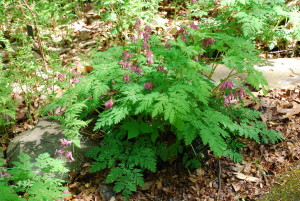One of nature’s delights in the late spring – early summer garden is the wonder of bleeding hearts (Dicentra spp.) in bloom (USDA hardiness zones 3-9). Fringed bleeding heart (D. exima) is a U.S. native to the Appalachian Mountains. Fringed bleeding heart exhibits deeply-cut, fern-like, grayish-green foliage on 10-15 inch tall plants. Dangling bright pink pendant (or heart) flowers are supported on arching stems. Flowers and plant size are smaller and leaves more deeply cut than its Asian cousins. Clumps continue to grow through summer compared to Asian species which disappear upon arrival of summer’s hot dry weather.
White-flowered cultivar ‘Alba’ with pale green foliage is a popular selection. Dr. Alan Armitage describes the cultivar named ‘Margery Fish’ for its white flowers and blue-green foliage on 10 inch high x 12 inch wide plants (zone 5) . He also singles out ‘Dolly Sods’ as a topnotch performer, particularly in Southern gardens; latter features blue-green leaves and heavy numbers of pink flowers. Popular cultivar ‘Luxuriant’ is likely a hybrid form. It grows 15-18 inches tall with pink flowers and dissected foliage; it often re-blooms during a late summer weather cool-down.
Plant in full to partial shade in compost-rich mildly acidic to slightly alkaline soil (6.0 -7.5 pH range). Soil drainage, particularly in clay soils must be well-drained; plants seem to linger or decline in too wet ground in winter. Garden centers usually sell dormant roots in packages or already growing in containers. Space plants or roots 18-24 inches apart in shade or part shade. Mulch lightly. In warm regions plants may die back and become dormant by late summer.
Clipping back plants to 4-6 inches after bloom usually will usually stimulate new foliage and spur a second flush of flowers in late summer. Flowers attract butterflies and hummingbirds. Aphids, slugs and snails occasionally feed on the leaves. Plants are deer and rabbit resistant. Bleeding hearts may self-sow in the garden.
Overcrowded clumps (rhizomes) may be divided in spring or fall. Best time to divide is just after flowering is complete or in very early in the spring before buds emerge. Dig up rhizomes, section into 2-4 buds (or eyes), and replant. Mix in several shovelfuls of rich compost to replenish the ground and lightly feed with a slow-release fertilizer. Light mulching is highly beneficial.
Bleeding hearts compliment other woodland plants such as ferns, lungwort (pulmonaria), brunneras, coral bells (Heuchera), and foam flowers (Tiarella).


 Posted in
Posted in 
